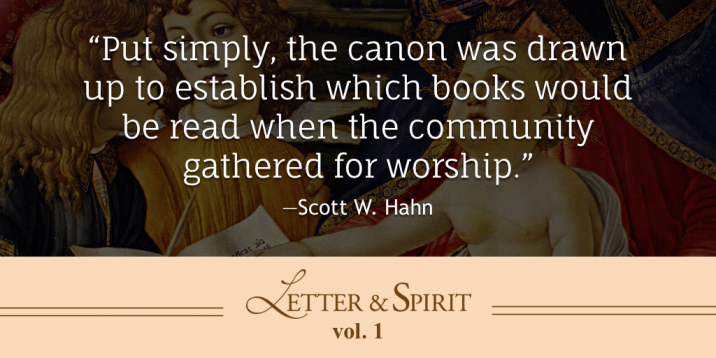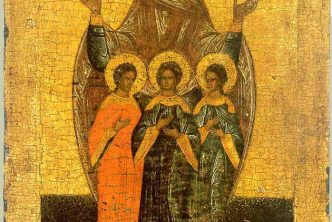
This month, you can get Letter and Spirit, vol. 1: Reading Salvation: Word, Worship, and the Mysteries for free plus two more volumes from the Letter and Spirit collection for less than $5! Throughout May, we’re sharing excerpts from Letter and Spirit, vol. 1 to give you a preview of thoughtful and thought-provoking scholarship you can expect from this month’s free book.
Today’s excerpt comes from the essay “Worship in the Word: Toward a Liturgical Hermeneutic” by S.W. Hahn, St. Paul Center for Biblical Theology:
Scripture’s Liturgical Content and Context
The recovery of Scripture’s liturgical sense is the product of two critical findings of modern biblical scholarship: First, the recognition of the final canonical shape of Scripture as essential for determining the meaning and purpose of individual passages and books of Scripture; and secondly, the identification of the covenant as Scripture’s keynote narrative theme. Together, these findings have helped us to see a unity between Scripture and liturgy that may be described as both formal and material. Their unity is formal in that Scripture was canonized for the sake of liturgy, and the canon itself derived from liturgical tradition. Their unity is material in that the content of Scripture is heavily liturgical.
Details about the origins of the canon as a definitive collection of sacred writings expressing the faith, worship, and instruction of the believing community remain elusive and are still debated among scholars. However, there is general recognition that the motives for establishing the canon were largely liturgical and that liturgical use was an important factor in determining which Scriptures were to be included in the canon. Put simply, the canon was drawn up to establish which books would be read when the community gathered for worship, and the books included in the canon were those that were already being read in the Church’s liturgy.
The scriptural canon, then, was enacted primarily as a “rule” for the liturgy (the Greek word κανών meaning, “rule or measuring stick”; see Gal 6:14–16). But textual analysis and form criticism have helped us see the profound shaping influence of liturgical use on the composition and final form of individual texts. In some cases—certain psalms, for instance—this is self-evident. And we know from internal evidence that many New Testament texts, especially the Epistles and the book of Revelation, were composed for the express purpose of being read in the eucharistic liturgy (see Rev 1:3; 1 Tim. 4:13). But close literary analysis has also enabled us now to see that the final form of the gospels reflects their use in the eucharistic worship of the early community. Some have even argued that the gospels’ final form was shaped by a kind of ongoing dialogue with the Jewish texts being read in the synagogue, especially for Israel’s great feasts.
We see then an original unity between the liturgy and the Bible. What establishes and constitutes that bond is God’s new covenant made in the blood of Jesus (Luke 22:20). The canon of Scripture—Old and New Testaments—was for the early Church what the “book of the covenant” was for Israel (see Exod 24:7; 2 Chron 34:30). Indeed, it is instructive that κανών was not originally the word applied to the list of biblical books. Eusebius, writing in the early fourth century, rather spoke of the Scriptures as “encovenanted” or “contained in the covenant” (ἐνδιαθηκος).
It is not surprising that many scholars have recognized the “covenant” as the recurrent and theologically significant theme in the canonical text. The vast literature on this topic cannot be rehearsed here. What has not been as well recognized is the crucial unity of both Scripture and liturgy in the establishment, renewal, and maintenance of God’s covenant relationship with his people. It is nonetheless true that the books of the new and old covenants are heavily liturgical in content. This is what I mean in describing a material unity between Scripture and liturgy—the Bible in many ways is about liturgy.
Much of the Pentateuch is concerned with ritual and sacrificial regulations; significant portions of the wisdom, historical, and prophetic books take up questions of ritual and worship. The New Testament, too, is filled with material related to the sacramental liturgy. The Gospel of John, for instance, unfolds as a kind of “sacramentary” in the context of the Jewish lectionary calendar; the Letter to the Hebrews and the book of Revelation contain sustained meditations on the meaning of the Christian liturgy, and the letters of Paul and Peter are animated by liturgical and cultic concerns. From Genesis to Revelation, it can be argued, Scripture is, by and large, about liturgy—about the proper way to worship God and receive his blessings. Often it is liturgy, or the culpable neglect of liturgy, that drives the biblical drama. Also, though this topic has not been well-studied, liturgy appears at the most significant junctures of the salvation history recorded in the canonical Scriptures.
Modern biblical scholarship, then, has helped us to discover not only the liturgical content of the Bible but the liturgical context in which the Scriptures were first written, transmitted, and canonized. With the acknowledgment of this material and formal unity between Scripture and the liturgy, we are now in the position to take these advances in biblical scholarship to their next logical and even necessary conclusion—to begin to undertake a “liturgical reading” of the canon of Scripture. My contention is this: Insofar as the canon of Scripture was established for use in the liturgy, and inasmuch as its content is “about” liturgy, it follows that we must engage Scripture liturgically if we are to interpret these texts according to the original authors’ intentions and the life-situation of the believing community in which these texts were handed on.
In what follows I want to begin this process of engagement. Through canonical analysis, I want to offer a reading of the “meta-narrative” of Scripture focusing on liturgy—what it is and how it functions in the Bible’s grand “story.” If I can be forgiven my use of overly long quotations in the notes, I intend here to be in dialogue with some of today’s most important biblical exegetes. I want to demonstrate how much of the best work being done in the field is leading us to see the liturgical sense of Scripture. At the same time, I hope to suggest ways in which a liturgical reading can unify and provide even greater explanatory and interpretive power to their insights and findings.
Such a sketch must necessarily be broad brush. But by focusing on the central moments in the canonical narrative—creation, the exodus, the Davidic monarchy, and the new covenant—I believe we will see the familiar biblical outlines in a new light. Further, from this liturgical reading, certain hermeneutical implications will emerge. These we will consider at the conclusion of this paper.
Hahn, S.W. (2005). “Worship in the Word: Toward a Liturgical Hermeneutic.” Letter & Spirit: Reading Salvation: Word, Worship, and the Mysteries, 1, 102–106.
***
Get the complete essay and more like it in Letter and Spirit, vol. 1, free through May 31! And add volume 2 and volume 3 from the Letter and Spirit collection for less than $5.
And don’t miss your chance to get the entire collection—the remaining eight volumes—for 23% off. With the combined steep discounts on the free book, plus one, and plus two, and dynamic pricing you’ll get on the collection, the savings really add up!





